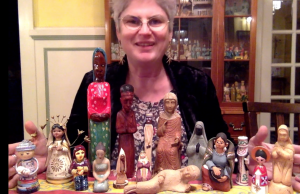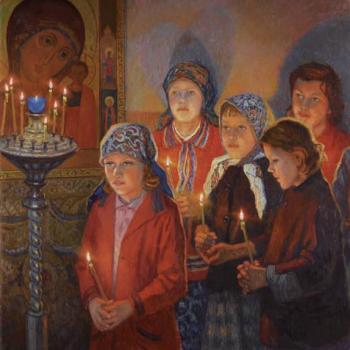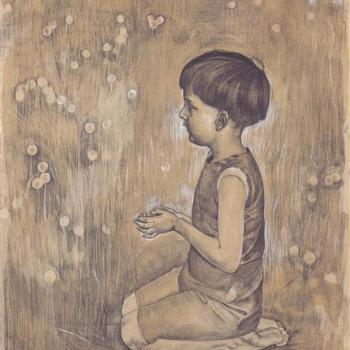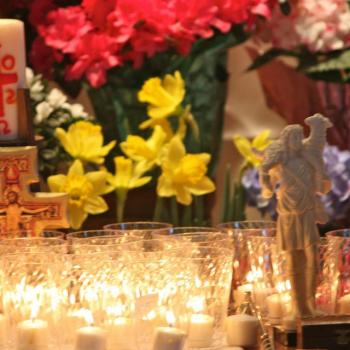
International Woman of Mystery
We don’t know what colors she preferred. Was she shy, prone to fits of laughter, or sober and absorbed in her own thoughts? Was her gaze direct? Did her voice carry, or did she speak in intimate tones, as though her words were meant only for you? When she entered a room, did she magnetize others by her ease and warmth? Or did she prefer to observe others in contemplative silence, from just outside the frame?
Meanwhile, she appears in different lands in the clothing particular to the local people, with their own characteristic facial features, speaking in each of their various languages. Sometimes she comes as a queen; other times, she’s a peasant.
Artists have given her every body type imaginable: she might rise like a tower among tiny doll-size people of lesser significance, or she could curl over: small, shadowed, and forgotten in her room. Her golden hair may billow, electrified with light in a bright cloud of honeyed goodness. Her tears might each reflect a different universe. She’s had wrinkles slice her tragic skin, or cheeks like pearls, whose rosy glow rivaled that of any natural bloom. Sometimes her hair springs black and sleek and pricey as a mink stole. Or she could be missing half the hair on the front of her head. I don’t think her feet have been bound, but I could be wrong about that.
Why so many disguises, Mary?
Yes, she’s everyone’s mother… and Everywoman, too. And yes, artists need to paint what they know. Also, as a type of the Church, she can’t appear just one way or maybe we’d be tempted to start trying to limit the scope of the Holy Spirit. Because we’re always trying to do that.
But couldn’t we have a few more concrete details? I mean, this wild freedom to imagine her any which way also has a dark side: kitsch Mary. We’ve all seen her. She glows in the dark! Her identical sisters crowd close to her on store shelves. She popped, fully clothed, from a plastic mold. The blue on her painted veil spills onto her face because a machine applied the color without looking. None of these flaws expresses the true horror of kitsch Mary, though: her expression and posture are impossible for any ordinary female to maintain for more than maybe seven seconds, if that.
Some might justify kitsch Mary’s lack of resemblance to any actual woman by claiming that the Mother of God’s perfection can’t be imitated by an ordinary mortal. Not only is this bad theology, it shows bad faith.
First we can tackle the bad theology: Mary’s perfection indicates that she didn’t sin, not that she was dead. Plenty of ordinary women who discover themselves in between sins have the appearance of animation, of wit, of joy, of daydreaming abstraction, perhaps, or even discomfort. But I have only ever seen one living woman who looked like a dead person (name withheld because it would be mean to identify her). Every other living woman I have met had the appearance of life. Kitsch Mary, on the other hand, has her hands folded in the manner of a corpse artfully arranged in a coffin. Though she poses upright, her eyes usually close (though when they are painted open, they have that glassy ten-mile zombie stare I imagine an open-eyed corpse might have). Upon close examination, one discovers that kitsch Mary has no bones in her face or hands. The only way to describe her expression is “air-brushed,” and here I’d like to say that most funeral directors do this to better effect with corpses than the inventors of kitsch Mary have “accomplished.” To try to reproduce this effect, Mary would have to spend several hours per day in front of the mirror and hundreds of dollars on product. Or be dead.
Only a person speaking in bad faith, a person who thinks it’s cosy to send people to a fine and private place – in sum, a person who secretly wants women to die – could assert that kitsch Mary has anything to do with perfection.
Perhaps kitsch Mary represents the price we have to pay for the wonder of the Virgen de Guadalupe living in the chapel next-door to Pani Nasza Częstochowska while remaining the exact same person (!). Or maybe people have to stop buying kitsch Mary. I’m sure this representation grieves her. Let’s do her a solid and choose better in the future.
How One Poet Imagines Her
she carries a book but it is not
the tome of the ancient wisdom,the pages, I imagine, are the blank pages
[…]
of the unwritten volume of the new;but she is not shut up in a cave like a Sibyl; she is not
imprisoned in leaden bars
in a colored window;she is Psyche, the butterfly,
out of the cocoon.
– H.D. from Trilogy
H.D. (short for Hilda Doolittle) grew up in Bethlehem, Pennsylvania, at the turn of the last century, about one hour from Ezra Pound’s family home. She befriended Pound when they were both students at the University of Pennsylvania, and for a brief time they were engaged to be married. Her poetry, particularly her book-length poem, Trilogy, employs intensely arresting images (““grape, knife, cup, wheat / are symbols in eternity, / and every concrete object / has abstract value, is timeless / in the dream parallel”), responds with acute sensitivity to the aerial bombing of World War II, which she survived (“let us not teach / what we have learned badly / and not profited by; let us not concoct healing potions for the dead, nor invent new colors for blind eyes.”), and, most deliciously, takes playful delight in palimpsests, which she defined as: “a parchment from which one writing has been erased to make room for another.”
In a series of deliberate partial erasures, H.D. builds up layers of meaning and allusion by superimposing elements from various mythologies and theologies that then begin to converse with one another. Her Mary recalls Eve, Aphrodite, Myrrh (whose “blood” turns to myrrh, one gift of the Magi), Psyche (as in the above fragment) and many other women. Mary becomes both a lens or film through which these other figures may be viewed and the half-hidden root and key to all their stories.
Mary’s freedom becomes H.D.’s preoccupation. She cannot be “imprisoned in leaden bars,” even those that might circumscribe a beautiful pane of colored glass. H.D. imagines that the pages in Mary’s book have yet to be written because she represents the new. This sense of freedom and possibility allows for flight, for the soul (“Psyche”) to travel from constricting entanglements into purer oxygen, where it may breathe.
Who Is She, Then?
Mary speaks four times in scripture: Luke 1:26-38, Luke 1:46-56, Luke 2:41-52, and John 2:1-11. She appears a few other times, without speaking (Mark 3:31, Luke 2:7:7, Luke 2:19, Luke 2:22. 34f, John 19:25ff, Acts 1:14), and studying those biblical references can deepen our understanding of her person. Anyone who wants to know her better could meditate on all the passages that mention her. I would caution against the practice of picking and choosing among the scripture passages for only those that fit a preconceived or desired purpose. The beauty of the spiritual life only dawns on us when we allow ourselves to receive the surprise. Those who approach a sacred text the way one might go to the store to buy something already on a shopping list will surely find what they look for. The better part, though, will elude them. If, on the other hand, we accept all mentions of Mary in scripture, censoring nothing, we discover divine paradox and the playfulness with which God breathes complexity into each human existence. Try it!
Another Great Source
After diving deeply into the above scripture references and before turning to any Marian apparitions, search for references to Mary in liturgical prayers and texts, especially in the prayers for Mass. These prayers help us to approach the mystery of Mary’s person without reducing her to a definition. They help us to discover the essential and to appreciate Mary’s centrality in the context of the Church’s celebrations. Because the Church doesn’t require us to accept the content of any apparitions, those sources are of secondary importance if approved, and likely to be distracting if not. Best to stay close to scripture and the liturgy when attempting to make Mary’s acquaintance.
How Best to Imagine Her
Even for those who don’t plan to paint her portrait or write her into a novel, it matters whether we imagine her with fidelity to the historical record or whether we conjure dead, boneless, air-brushed images when we contemplate her. Who wants a relationship with a nonexistent figment? The most delightful aspect of friendship comes when the other person startles us with something we could not have anticipated. Then we remember that we didn’t invent our friend, that she has an entire, rich, and luminous life that comes from without, where a new day brings unexpected gifts for us to open.
* * *
Please Mary, you know that the world is groaning in labor pains because it has such an intense need for your son, Jesus, our Great Peace. Remind him, please, that we need to be drunk on the wine of his peace, but we have so little of it. We need more wine! We promise to do whatever he tells us. Amen.











